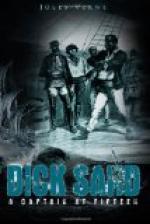Fortunately, the ant-cone, with its thick walls, was perfectly impervious. A beaver’s hut, of well-beaten earth, could not have been more water-tight. A torrent could have passed over it without a single drop of water filtering through its pores.
As soon as Dick Sand and his companions had taken possession of the cone they occupied themselves in examining its interior arrangement. The lantern was lighted, and the ant-hill was sufficiently illuminated. This cone, which measured twelve feet in height inside, was eleven feet wide, except in its upper part, which rounded in the form of a sugar loaf. Everywhere the walls were about one foot in thickness, and there was a distance between the stories of cells which adorned them.
We may be astonished at the construction of such monuments, due to these industrious swarms of insects, but it is true that they are frequently found in the interior of Africa. Smeathman, a Dutch traveler of the last century, with four of his companions, occupied the top of one of these cones. In the Lounde, Livingstone observed several of these ant-hills, built of reddish clay, and attaining a height of fifteen and twenty feet. Lieutenant Cameron has many a time mistaken for a camp these collections of cones which dotted the plain in N’yangwe. He has even stopped at the foot of great edifices, not more than twenty feet high, but composed of forty or fifty enormous rounded cones, flanked with bell-towers like the dome of a cathedral, such as Southern Africa possesses.
To what species of ant was due, then, the prodigious style of architecture of these cones?
“To the warlike termite,” Cousin Benedict had replied, without hesitating, as soon as he had recognized the nature of the materials employed in their construction.
And, in fact, the walls, as has been said, were made of reddish clay. Had they been formed of a gray or black alluvian earth, they must have been attributed to the “termes mordax” or the “termes atrox.” As we see, these insects have not very cheering names—a fact which cannot but please a strong entomologist, such as Cousin Benedict.
The central part of the cone, in which the little troop had first found shelter, and which formed the empty interior, would not have contained them; but large cavities, in close contact, made a number of divisions, in which a person of medium height could find refuge. Imagine a succession of open drawers, and at the bottom of those drawers millions of cells which the termites had occupied, and the interior disposition of the ant-hill is easily understood. To sum up, these drawers are in tiers, like the berths in a ship’s cabin. In the upper ones Mrs. Weldon, little Jack, Nan, and Cousin Benedict took refuge. In the lower row Austin, Bat, and Acteon hid themselves. As for Dick Sand, Tom, and Hercules, they remained in the lower part of the cone.
“My friends,” then said the young novice to the two blacks, “the ground is becoming damp. We must fill it up by crumbling the red clay from the base; but take care not to obstruct the hole by which the air enters. We cannot risk being smothered in this ant-hill.”




